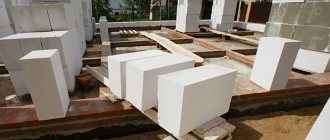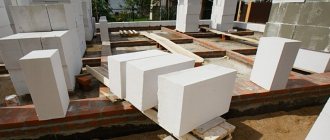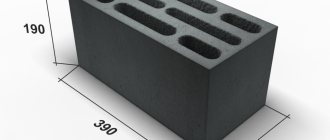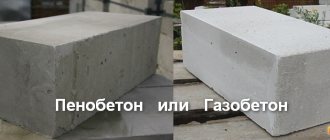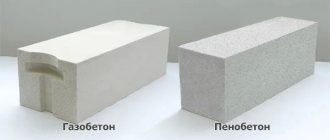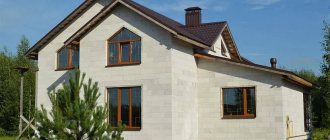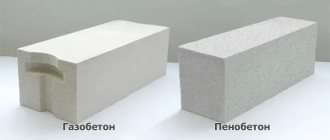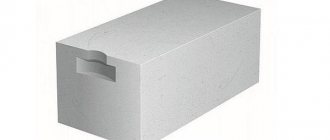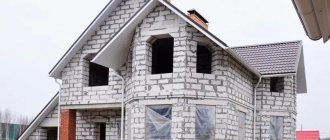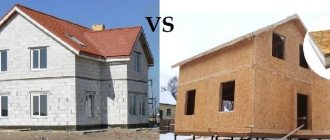What to glue aerated concrete blocks to - Glue for aerated concrete
Finishing aerated concrete walls inside and outside yourselfWhat tools are needed to build a house from aerated concrete?Wall blocks made of cellular concrete – Buy in St. Petersburg
—
Where to buy aerated concrete in St. PetersburgPartition blocks made of cellular concrete - for interior partitions in St. Petersburg
Brand of density of aerated concrete - what is it
The density of aerated concrete depends on the number of pores in the volume. They are formed as a result of a chemical reaction during the hardening of a concrete mass made from cement and quartz sand. For this purpose, special gas-forming compounds are used. The more pores filled with gas, the lower the density of the material. With a lower value of this characteristic, aerated concrete also has lower thermal conductivity.
Expert opinion Vitaly Kudryashov builder, aspiring author
Ask a Question
The designation of the material consists of the letter D (density) and a number indicating the approximate volumetric weight of the material in a dry state in kg / cubic meter. m.
There are the following types of aerated concrete:
- thermal insulation - up to D300;
- structural and thermal insulation - D300-D400;
- structural - D500 and higher.
Low-density aerated blocks are not used for the construction of structures bearing heavy loads. Conversely, blocks with a high density are the least thermally efficient, conducting heat well. The strength of blocks depends on density only indirectly. With the same density, products can have different strength classes. This is explained by the use of different materials in manufacturing. By increasing the grade of cement, the class of concrete is increased.
Load-bearing capacity of aerated blocks
The load-bearing capacity of aerated concrete is understood as its ability to withstand loads without destruction. This characteristic depends on the strength of the material. And strength depends on density.
Aerated concrete only bears compressive loads. When stretched, it breaks easily. Therefore, this material is used in compressed structures. To determine compressive strength, the concept of concrete class is used. This designation includes the capital Latin letter B followed by a number indicating the size of the maximum compressive load in MPa that the material can withstand. For example, if class B2.5-B3.0 is provided for aerated concrete brand D600, then the material is guaranteed to withstand compression of 2.5-3.0 MPa, and in more conventional units of measurement the value will be approximately 25-30 kg/cm². This is the load-bearing capacity of aerated concrete.
Characteristics of aerated concrete density grades (D100, D200, D600, D700, D800, D900)
Blocks made of aerated concrete grades up to D200 are usually characterized by class B0.5, which allows them to withstand loads of no more than 5 kg/sq. cm. In practice, strength calculations of such blocks are not carried out, but the equivalent surface density of aerated concrete is used. This characteristic is equal to the usual density multiplied by the layer thickness.
Accordingly, it is measured in kg/sq. m. The frost resistance of such blocks is designated F35, which ensures guaranteed preservation of operational properties during 35-fold freezing and thawing in a water-saturated state.
Structural materials of grades D600, D700, D800, D900 meet the requirements for class D2.5-D3.5. They are able to withstand loads of up to 35 kg/sq.m. cm. This is a high strength indicator, allowing use in loaded structures. Some manufacturers bring the strength of their products to class B5.0. These blocks can withstand loads of up to 50 kg/sq.m. see. The frost resistance of products made from structural aerated concrete reaches 100 cycles, which corresponds to the F100 grade.
Main characteristics of aerated concrete
The list of parameters for any building material is quite large. For the user, many of them are not of fundamental importance. When choosing a suitable material, only the main indicators that directly determine the working and performance qualities of the material are considered. The main technical characteristics include:
- density;
- weight;
- thermal conductivity;
- frost resistance;
- strength;
- price.
The last indicator is not technical, but its significance in the eyes of many buyers exceeds many parameters of the material.
Dimensions of aerated concrete block GOST
The sizes of aerated concrete blocks from different manufacturers may vary. GOST 31360 “Wall products not reinforced from autoclaved cellular concrete. TU" regulates their maximum value. Thus, the length of products cannot exceed 625 mm, and the height or width - 500 mm.
The maximum deviations in block sizes cannot exceed:
- length - ±4.0 mm;
- width - ±3.0 mm;
- height - ±4.0 mm.
Deviations from the rectangular shape are checked by measuring and comparing the sizes of the diagonals, and the difference cannot exceed 4.0 mm. Autoclave curing blocks usually have smaller dimensional deviations than natural drying blocks. The blocks may have grooves or ridges at the ends, providing better tightness of vertical seams due to the interlocking connection. For ease of installation, products can be equipped with grip pockets. This is important when blocks weigh more than 25-30 kilograms.
A separate category of products is U-blocks. They have a recess along one of the long sides, located along the product. In this case, the walls of the block can have a thickness from 50 to 70 mm. The notch can be made by sawing out the middle part from a standard block.
How to determine the required parameter
The modern building materials industry in the domestic format allows consumers to use several main types of aerated concrete material. The density of a block or slab intended for construction and finishing can be determined by the nomenclature designations of the product range. The density level of an aerated block is indicated by the amount of solid matter that has undergone all technological stages of processing per cubic meter of material. If the D500 product range has half a ton of solid fractions, then the D300 has only 0.3 tons. The specific structural and thermal insulation characteristics, weight category and cost of the estimate depend on how dense this type of concrete is.
In the video - manufacturers of autoclaved aerated concrete:
According to standard data from manufacturers, it is easy to determine density indicators and other technical parameters.
- Products with a density of 500 are defined by experts as the most durable materials. Due to its high strength - from 28 to 40 kg per square meter. cm D 500 is used exclusively for the construction of walls in buildings and structures that are a load-bearing element. Aerated concrete blocks of this brand are distinguished by the fact that they can withstand loads of the following order. On the surface of a block of 50.0 cm x 36.5 cm, pressure corresponding to loads of about ninety tons can be applied without consequences with an actual compressive stress of 4.93 MPa. At the same time, masonry made from this material is the heaviest for the foundation, therefore, before making a decision on the use of this product, the calculation documentation drawn up by the architect, designer and the provisions of regulatory documents.
- For products of category D 400 One can observe the highest popularity among gas blocks. If this product is completely inferior in the field of thermal insulation, then its density does not allow its use in the construction of residential and capital construction projects of more than one floor. However, this material has its positive sides. A block with standard dimensions can only withstand forty-five tons, with a physical stress of 2.47 MPa, but masonry made from D400 exerts significantly less serious pressure on the foundation and soil.
- Aerated concrete block with density D 300 has the smallest weight in the product range. However, this particular material has truly unique thermal insulation properties. It is absolutely not suitable for structural loads, but this block can rightfully be called ideal for insulation. Light weight and relatively low price make it possible to widely use grade 300 for the construction of internal partitions.
It is most important to correctly calculate the loads and density ratio, taking into account the mass and weight of connecting materials, such as cement, specialized adhesive mixtures and their analogues.
Which brand of aerated concrete density to choose for building a house
When deciding on the use of aerated concrete blocks for building a house, it is necessary to take into account the thickness, thermal conductivity and strength of the material. Depending on the combination of these properties, a grade is assigned according to density. The following are general recommendations for selection:
- for one-story buildings with wooden floors, the use of grade D300 with a wall thickness of 250-300 mm will provide comfort even without additional insulation; sometimes such material is used to create courtyard buildings in private households;
- It is recommended to build two- or three-story houses from aerated concrete D400-D500, which will provide the necessary strength and rigidity of wall structures even when installing heavy reinforced concrete floors;
- for multi-storey buildings it is better to use blocks of grades D600 and higher.
Expert opinion Vitaly Kudryashov builder, aspiring author
Ask a Question
Using an inappropriate brand can lead to loss of structural strength or unreasonably high heating costs for the future building.
The optimal type of gas blocks for private housing construction
Choosing materials for building a private house is not an easy task. It is necessary to select a gas block (or, as it is sometimes mistakenly called, a gas silicate block) with the specified parameters. The material must meet several requirements:
- sufficient strength, load-bearing capacity;
- light weight;
- low thermal conductivity;
- high degree of sound insulation.
Simply put, it is necessary to combine low weight with high strength and load-bearing capacity, as well as ensure heat conservation of enclosing structures (external walls). The complexity of the problem lies in the contradictory requirements - with an increase in mechanical strength, the size of the bubbles decreases (density increases). Accordingly, the weight and load on the foundation increases, and heat saving decreases noticeably. It is necessary to choose a certain average value that gives the optimal ratio of contradictory parameters.
In terms of the ratio of strength, thermal conductivity and mass of blocks, aerated concrete grade D500 is most preferable. Sometimes they use the D600 brand, which has a higher density, but, in general, is approximately equal in all respects. This is done if construction is carried out in difficult conditions and requires the use of more durable components. However, it is not advisable to use heavier grades of aerated concrete. Their parameters are already approaching those of conventional heavy concrete or brick, and the advantages of aerated concrete are disappearing. A situation arises when it is easier and cheaper to build from traditional building materials that do not require additional actions (for example, installing protective sheathing).
Let's summarize what has been said. The density of gas silicate blocks is not just one of the technical indicators of the material. This parameter combines all the main characteristics, determining the general properties of gas blocks of this brand. The degree of density determines heat saving, weight, load-bearing capacity and the maximum permissible number of floors of a building made from a given material. When choosing a material, it is enough to find out the density of a particular brand. The remaining indicators can be ignored, since they are derived from the main characteristic.
Area of use of aerated concrete blocks (D100, D200, D600, D700, D800, D900)
The use of products made from building materials of grades up to D200 is allowed for the construction of enclosing structures in frame buildings, including multi-story ones. But the main application is the creation of an insulating layer in multi-layer aerated concrete walls. That’s why some manufacturers call it “stone insulation.”
Aerated concrete blocks of grades D600, D700, D800, D900 are used for the construction of load-bearing walls (internal and external) in multi-storey buildings. Products with a thickness of 100-150 mm are used in the construction of internal partitions and ventilation shafts. U-blocks are used to create beams, lintels, and reinforced concrete belts when constructing walls. The shape of such products allows them to be used as permanent formwork for concrete mixtures.
The operating conditions of the building depend on the correct choice of aerated concrete brand. Such a building will provide comfort throughout its entire lifespan.
Calculation of aerated concrete for crushing
The calculation of blocks for crushing is carried out if the material is exposed to a large load applied to a small area. Such conditions arise, for example, when constructing floors, especially if they are made along beams. In this case, the small supporting platform of the beam bears the load collected along its entire length.
In places of support, collapse of aerated concrete can occur, that is, irreversible destruction within the material. The resulting stresses can simply crush the blocks; they will chip under the influence of the load. To prevent this phenomenon, a calculation is necessary. For it, it is enough to determine the magnitude of the stresses arising from the applied load and compare it with the calculated resistance of aerated concrete.
The stresses are equal to the ratio of the load value to the area of support. For example, if a weight of 2 tons is applied to a wooden beam, then one end of it will press on the aerated concrete masonry with a force of 1 ton (1000 kg). With a beam thickness of 100 mm (10 cm) and a support value of 250 mm (25 cm) on blocks of aerated concrete class B1.5, the area of the support platform will be equal to 250 sq. cm.
By dividing the load by the area of the support area, you can get a stress value of 1000 kg/250 cm² = 4 kg/cm².
Comparing the magnitude of the stresses with the calculated resistance, which for simplicity can be taken knowing the class of aerated concrete - 1.5 MPa or 15 kg/cm², you can see that the strength of the material will be sufficient to support the floor beam. However, this example is provided only to show the calculation mechanism and does not take into account the entire load on the wall. In real conditions, aerated concrete is also pressed by the mass of aerated concrete on the walls of the upper floor, the roof and the weight of the snow load. Therefore, the pressure on the support platform may exceed the permissible value. With a value of 5 tons, the stresses arising in aerated concrete will be equal to 20 kg/cm². And this will already exceed the value of the calculated resistance due to concrete class B1.5.
So what, should we abandon the use of concrete of this class? Not at all, there is a solution to the problem.
Manufacturers
The real construction boom that is happening these days in almost every region and region of our country is due to the use of modern technologies in the production of air-saturated building materials. The technique of strengthening or so-called welding of the shell of each fragment of a block, partition or slab through autoclaving allows us to obtain material that meets the highest international standards.
In addition to all the positive qualities and standards listed above, autoclaved aerated concrete is a highly hygienic, environmentally friendly and safe building material for humans, which today is one of the objects of foreign trade. Due to the fact that numerous domestic and foreign companies use technologies for processing secondary raw materials and mining waste, large and small firms and companies produce gas- and foam-concrete products.
Russian manufacturers
The most famous manufacturers of foam concrete in our country have long gained recognition and popularity among developers. These are Russian companies such as:
- PENOBLOK.RU.
- BESTO company, Moscow.
- .
- FPP “ALVICO”.
- .
- Leroymerlin Company.
Foreign manufacturers and importers
Among foreign manufacturers of aerated concrete, due to their quality and price, companies from Belarus - ILGUCIEMS SIA, Poland - brands Itong, Solbet, N+N, and Ukraine - LLC YUDK, AEROC Berezan, PC Stonelight, which supply blocks of European quality, stand out favorably.
With any choice, it is necessary to comply with the standards and estimates drawn up by a professional architect. It is especially important to comply with technical parameters when composing various types of this artificial stone, which will allow the construction of a durable, reliable, safe building for residential and other purposes.
Vapor permeability
This quality allows the material to absorb moisture to some extent and release it when the temperature changes. However, unlike wood, where the passage of moisture depends on the direction of the fibers, in aerated concrete moisture accumulates and is released equally from both sides of the block, that is, both outside and inside the building. Therefore, this material has to be protected.
However, the vapor permeability of indoor walls provides a healthier microclimate. Therefore, this quality of aerated concrete should be considered an advantage. The following table is devoted to this characteristic of aerated concrete.
| Aerated concrete | Brand, D | Vapor permeability mg/(m*h*Pa) |
| Thermal insulation | 200 | 0,3 |
| 250 | 0,28 | |
| 300 | 0,26 | |
| 350 | 0,25 | |
| Structural and thermal insulation | 400 | 0,23 |
| 450 | 0,21 | |
| 500 | 0,2 | |
| 600 | 0,16 | |
| 700 | 0,15 | |
| 800 | 0,14 | |
| Structural | 900 | 0,12 |
| 1000 | 0,11 | |
| 1100 | 0,1 | |
| 1200 | 0,09 |
Environmental friendliness
Cellular concrete is one of the most environmentally friendly building materials, its coefficient is 2. For comparison, wood is assigned an indicator of 1.
However, this is only true for non-autoclaved aerated concrete. Autoclave requires increased energy consumption during production, which somewhat worsens its performance. However, the safety of the finished product for humans and the environment is absolute.
Aerated concrete is a building material that fully justifies itself in its field. At the same time, the variety of properties of concrete of different categories significantly expands this area.
Frost resistance
Determines the number of complete freeze-thaw cycles that a material can endure without destruction. Aerated concrete is porous concrete with a very high level of water absorption, so its frost resistance indicators are not too high.
This parameter is adjusted according to its purpose and expected operating conditions:
- F15 – for partitions and internal walls;
- F25 – for external walls.
Comparison of prices for facade insulation
- The cost of a cubic meter of D200 aerated concrete is about 4,500 rubles.
- The cost of a cubic meter of stone wool is 2500 rubles.
- The cost of a cubic meter of polystyrene foam is 1,500 rubles.
The lower the thermal conductivity value, the better the thermal insulation.
Thermal conductivity coefficients:
- aerated concrete D200 - 0.05.
- mineral wool – 0.04
- polystyrene foam – 0.035
